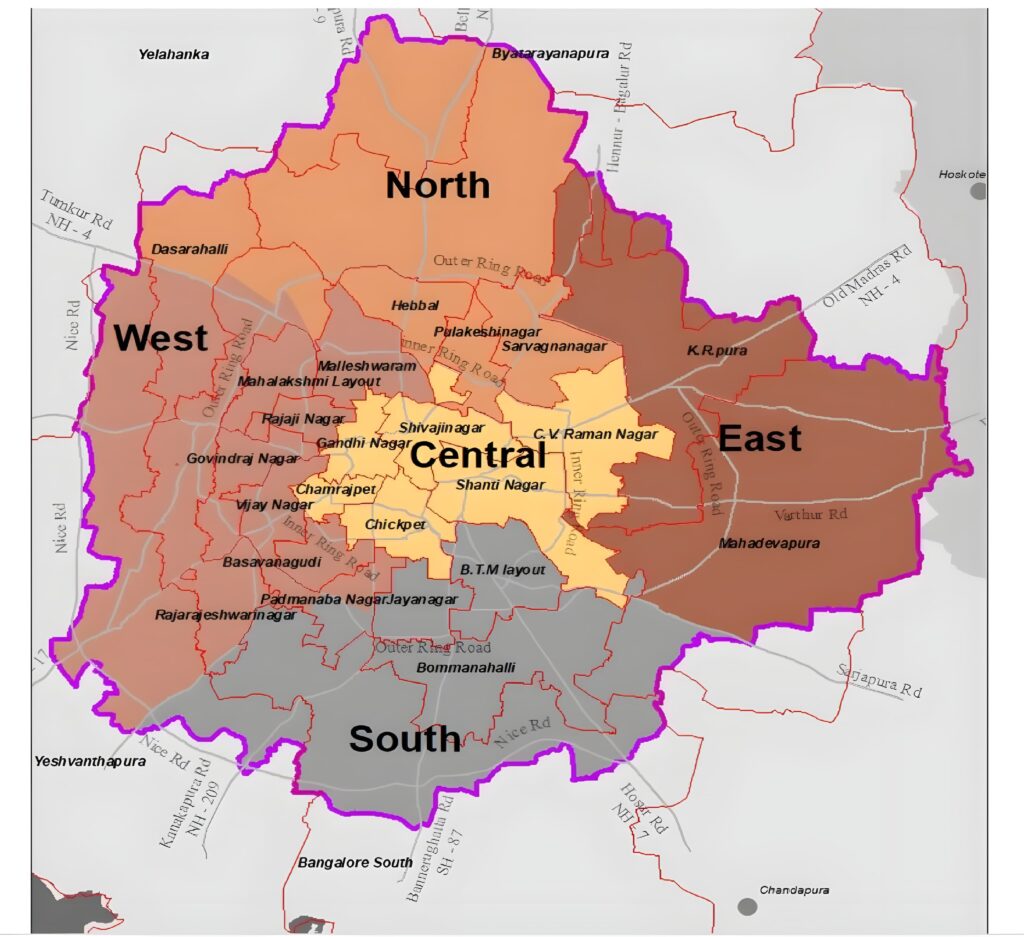
Map of five corporations
East Bengaluru ranks richest, North poorest in city’s new five-corporation model
Bengaluru
As the Karnataka government proceeds with its ambitious plan to divide the Bruhat Bengaluru Mahanagara Palike (BBMP) into five city corporations, new data shows a stark fiscal and demographic imbalance across the proposed zones.
While East Bengaluru will contribute the highest share of property tax, North Bengaluru — despite being among the most populous — will bring in the least revenue. Even West Corporation is also features in the bottom with least revenue projections.
The five municipal bodies — Central, East, North, South, and West — have been carved out under the Greater Bengaluru Governance Act, 2025, which aims to decentralise administration and improve civic services across the city’s 712 sq km jurisdiction.
These corporations are expected to operate independently, with their own budgets, planning authorities, and service delivery mechanisms.
According to official estimates, East Bengaluru will generate ₹912 crore in property tax in 2025 — the highest among all five zones. In contrast, North Bengaluru is projected to bring in only ₹543 crore, making it the weakest in terms of municipal revenue despite having a population of 3.1 million.
| Corporation | Area (sq km) | 2023 Population (mn) | 2025 Property Tax+ (₹ Cr) | Population Density (/sq km) |
|---|
| Central | 78 | 2.5 | ₹659 Cr | 32,051 |
| East | 168 | 1.3 | ₹912 Cr | 7,738 |
| North | 158 | 3.1 | ₹543 Cr | 19,620 |
| South | 147 | 3.0 | ₹733 Cr | 20,408 |
| West | 161 | 4.5 | ₹580 Cr | 27,950 |
| Total | 712 | 14.4 mn | ₹3,427 Cr | 20,225 avg |
East delivers more with less
Despite having the second-lowest population, East Bengaluru’s economic output is disproportionately high — likely due to its concentration of commercial hubs, IT parks, and high-value residential developments. Meanwhile, North and West Bengaluru, with large populations, contribute comparatively less, reflecting the lower property values and informal nature of many settlements in these areas.
Central Bengaluru, though the smallest in area (78 sq km), has a population of 2.5 million and the highest population density at over 32,000 people per square kilometre. Urban planners expect this zone to rely on vertical growth and transit-oriented development to accommodate future expansion.
The variation in both revenue and population poses a challenge for policymakers. While the government has tried to balance population sizes and reduce the splitting of assembly constituencies, financial disparities across corporations may still require interventions or fiscal transfers from the state to ensure equitable service delivery.
Officials involved in the exercise said that over 15 simulations were conducted before finalising the five-corporation model. The chosen configuration, they said, offers the most practical trade-off between financial balance, governance efficiency, and administrative convenience.
Here’s the link to map of five new corporations:
https://brandblr.github.io/brandblr
Why five corporations?
Based on simulations and feasibility studies, the Brand Bengaluru Expert Committee (BBEC) — which worked on the proposal — concluded that five corporations offer the best balance between governance efficiency and scalability for future growth. Key considerations included:
- Minimum population threshold of 1 million per corporation
- Population density above 5,000 persons per sq km
- Balanced property tax revenue, with limited dependence on state subsidies
- Minimising the splitting of Assembly constituencies
- Improved citizen access to local governance services
- Wider road-based boundaries for administrative clarity
- Potential for vertical growth and densification, especially in Central Bengaluru
Although earlier models explored three or four corporations, they either failed to meet population or revenue criteria or led to excessive division of assembly constituencies.
The proposed division ensures five assembly constituencies are split, which could see limited political and administrative disruptions.
